Free Courses Sale ends Soon, Get It Now


Free Courses Sale ends Soon, Get It Now



Copyright infringement not intended
Picture Courtesy: https://mantraya.org/analysis-israels-war-in-gaza-curtains-drawn-on-the-india-middle-east-europe-corridor-project/
Context: Israeli Transport Minister declares a new trade route using Mundra port, Gujarat, to avoid the Red Sea due to Houthi attacks on Israel-linked ships.
Details
Key Steps in the New Route
Sea Transport
Land Transport
Benefits of the New Route
Potential Challenges
|
Connection to Larger Project (IMEC) ●The newly introduced trade route is seen as more than a tactical response; it is also considered a potential test case for the larger India-Middle East-Europe Economic Corridor (IMEC) project. ●IMEC aims to establish a comprehensive economic corridor connecting India to Europe through the Middle East. However, the exact form and successful implementation of the IMEC project remain uncertain, and recent events, including the conflicts, have introduced complexities. |
Conclusion
Must Read Articles:
India-Middle East-Europe Economic Corridor: https://www.iasgyan.in/daily-current-affairs/india-middle-east-europe-economic-corridor
Black Sea, Red Sea & Panama Canal: https://www.iasgyan.in/daily-current-affairs/black-sea-red-sea-panama-canal#:~:text=Red%20Sea%20is%20a%20narrow,continents%20of%20Africa%20and%20Asia.
|
PRACTICE QUESTION Q. Critically evaluate the potential economic benefits and drawbacks of the India-Middle East-Europe Economic Corridor (IMEC) for each of the following regions: India, the Middle East, and Europe. Consider factors such as trade diversification, infrastructure development, job creation, and potential security concerns. Answer Structure: 1.Briefly introduce the IMEC initiative, highlighting its goals and geographical coverage. State the key aspects mentioned in the question, like trade diversification, infrastructure development, job creation, and security concerns. 2.Discuss how IMEC can help diversify trade, opening up new markets and reducing dependence on existing routes. Analyze the potential for increased trade volume and its impact on economic growth, employment generation, and investment opportunities. 3.Analyze potential challenges in realizing the projected benefits like infrastructure gaps, high investment costs, and bureaucratic hurdles. Discuss concerns about unfair trade practices or dominance by specific regions within the corridor. Mention potential security threats disrupting trade flows or causing infrastructure damage. 4.Summarize key findings on the potential economic benefits and drawbacks for each region. Offer a balanced and nuanced perspective, acknowledging both the potential advantages and the need to address possible challenges. Additional Tips: ●Use specific examples and data to support arguments whenever possible. ●Maintain a neutral and objective tone throughout the answer. ●Ensure the answer is well-structured, coherent, and adheres to the word limit. |
© 2024 iasgyan. All right reserved